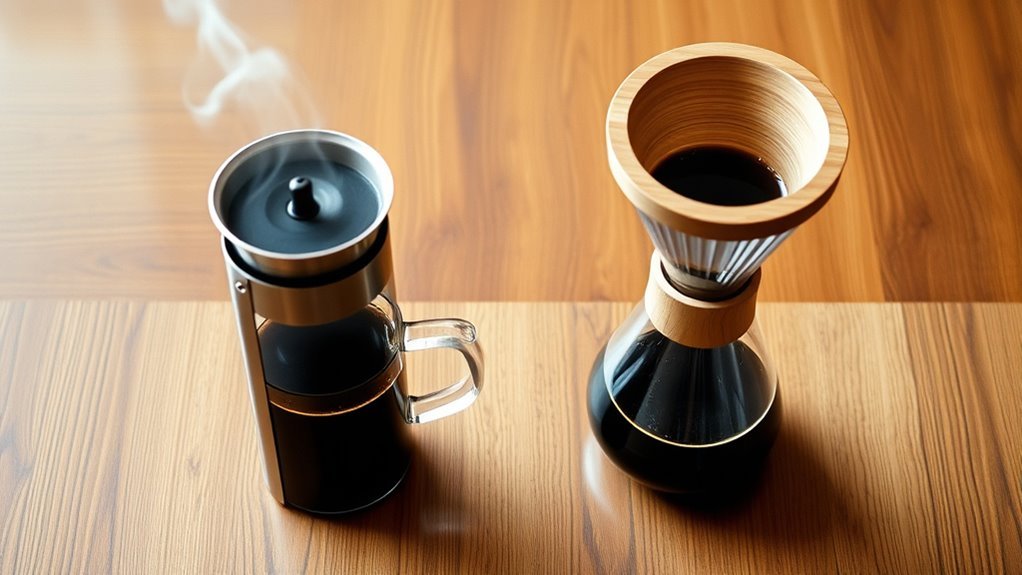Exploring Different Coffee Brewing Methods: Aeropress vs. Chemex
If you prefer a bold, rich brew with quick extraction and easy cleanup, Aeropress suits you with its pressure-driven method and medium-fine grind. Chemex, using a slower drip and thick paper filters, delivers a cleaner, brighter cup highlighting delicate floral and fruity notes, ideal if you enjoy nuanced flavors and a more deliberate ritual. Both require precise grind size and control, but your choice hinges on whether you prioritize speed or subtlety—there’s much more to uncover about each method’s nuances.
Overview of the Aeropress Brewing Method
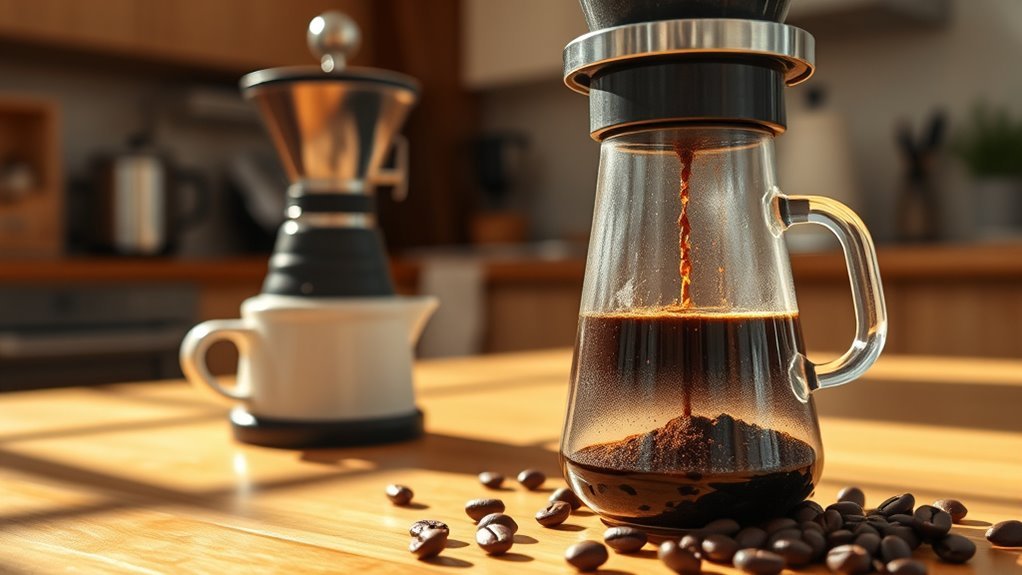
Although the Aeropress brewing method may seem unconventional at first, you’ll quickly appreciate its precision and versatility once you understand its mechanics. The Aeropress advantages stem from its unique design, which combines immersion and pressure to extract coffee efficiently. You control variables such as water temperature, brewing time, and grind size, allowing you to tailor each cup to your preferences. Its compact size and durable materials also grant you freedom to brew anywhere without sacrificing quality. Aeropress techniques vary from standard to inverted methods, each offering distinct flavor profiles and extraction control. By mastering these techniques, you can experiment confidently, revealing a spectrum of tastes that emphasize clarity, body, or acidity. This precision and adaptability make the Aeropress a powerful tool for coffee enthusiasts seeking freedom in brewing.
Overview of the Chemex Brewing Method
The Chemex brewing method offers a refined approach to coffee extraction that emphasizes clarity and balance. Rooted in Chemex history since 1941, its iconic hourglass-shaped Chemex design combines form and function, using a thick paper filter that removes oils and sediment. When you brew with Chemex, you control variables like pouring speed and water temperature, which impact flavor precision and extraction uniformity.
| Aspect | Details | Impact on Coffee |
|---|---|---|
| Chemex Design | Glass carafe with wood collar | Heat retention, aesthetic appeal |
| Filter Thickness | Extra thick paper filter | Cleaner cup, less bitterness |
| Pour Technique | Slow, circular pouring | Even extraction, enhanced clarity |
| Brew Time | 3-4 minutes | Balanced body and acidity |
This method suits you if you seek freedom in crafting a crisp, nuanced cup.
Equipment and Materials Needed for Aeropress
Mastering the Aeropress starts with understanding the essential equipment and materials required for ideal brewing. At its core, you’ll need the Aeropress device itself, including the chamber, plunger, and filter cap. Paper filters or reusable metal filters serve as your filtration options, influencing clarity and taste. Freshly ground coffee with a medium-fine grind complements the Aeropress’s rapid extraction. Hot water at about 175–205°F optimizes flavor balance. Beyond basics, consider Aeropress accessories like a precise scale, a gooseneck kettle for controlled pouring, and a stirrer to manipulate extraction. These tools empower you to experiment with Aeropress recipes, revealing diverse flavor profiles. Each component plays a critical role, giving you freedom to tailor your brew’s strength, clarity, and complexity with precision and consistency.
Equipment and Materials Needed for Chemex
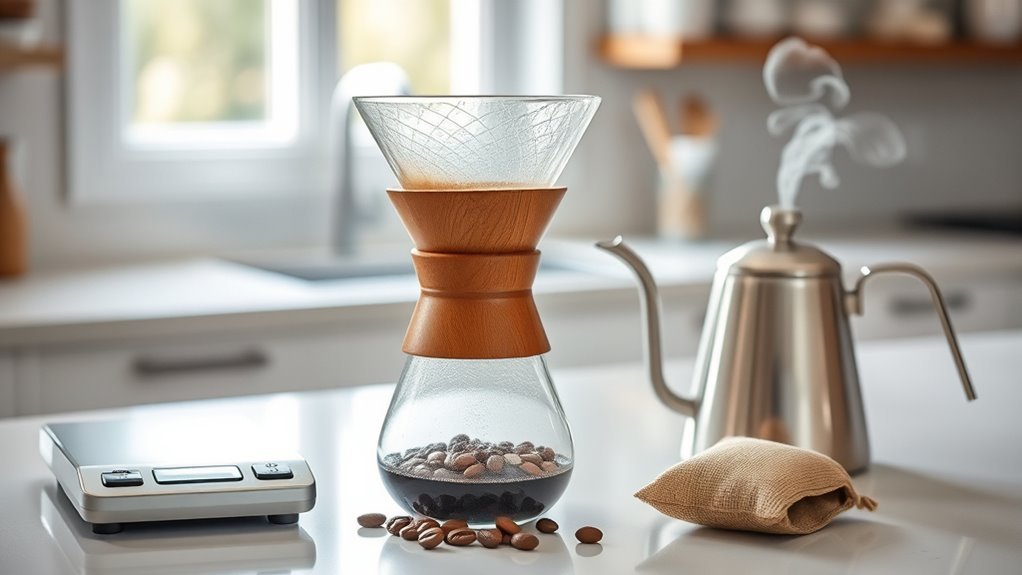
Brewing with a Chemex demands specific equipment and materials to release its signature clean and bright cup. First, you’ll need the Chemex brewer itself, renowned for its elegant glass design that’s both functional and visually appealing. The thick, proprietary Chemex filters are essential—they’re thicker than standard paper filters, guaranteeing ideal extraction by removing most oils and sediment, which delivers clarity in flavor. You’ll also want a quality burr grinder to achieve a medium-coarse grind, vital for balanced brewing. Precision tools like a gooseneck kettle for controlled pouring and a scale to measure coffee and water guarantee consistency. Each element is designed to give you control and freedom in your brewing, enabling you to craft a cup that’s distinctly refined and true to the Chemex method.
Brewing Process and Techniques Compared
When you compare brewing processes, you’ll notice that each method requires specific grind sizes and consistent particle distribution to optimize flavor extraction. You’ll also see that extraction times vary considerably, influencing the balance between under- and over-extraction. Understanding these distinctions helps you tailor your technique to achieve the best cup possible.
Brewing Steps Overview
Although each coffee brewing method has its unique characteristics, the fundamental steps involved in extracting flavor remain consistent across techniques. As a coffee enthusiast, understanding these brewing techniques empowers you to experiment freely and refine your craft. Both Aeropress and Chemex require precise pouring, timing, and immersion to reveal nuanced flavors. Here’s a concise overview highlighting key stages:
| Step | Aeropress | Chemex |
|---|---|---|
| Preparation | Assemble device, add filter | Place filter, rinse with water |
| Coffee Dose | Add finely ground coffee | Add medium-coarse ground coffee |
| Blooming | Pour small water amount, stir | Pour water to saturate grounds |
| Brewing | Press after steeping | Slow, circular pouring |
| Serving | Directly into cup | Pour brewed coffee out |
This structured approach lets you compare and adapt steps to match your taste preferences and lifestyle.
Grind Size and Consistency
Since grind size directly influences extraction rate and flavor clarity, understanding its role is essential for mastering different brewing methods. When using an Aeropress, you’ll want a medium-fine grind size that promotes a balanced extraction within a short brew time, while also ensuring a clean cup. In contrast, the Chemex requires a coarser grind size to allow water to flow steadily through its thick filter, preventing over-extraction or clogging. Equally important is grind consistency; uneven particles lead to uneven extraction, causing bitterness or sourness. Using a burr grinder helps achieve uniformity, giving you control over the final cup’s clarity and body. By tailoring grind size and maintaining grind consistency, you gain the freedom to highlight your coffee’s nuanced flavors, whether you prefer the Aeropress’s intensity or the Chemex’s brightness.
Extraction Time Differences
Understanding extraction time differences is essential because it directly impacts the flavor profile and strength of your coffee. With Aeropress, extraction time usually ranges from 1 to 3 minutes, offering a faster brew that emphasizes clarity and boldness. Chemex, however, requires a longer extraction, typically 4 to 5 minutes, allowing for nuanced flavors to develop through slower water flow. These extraction variables—time, temperature, and agitation—interact to influence the brew strength and balance. Shorter extraction favors brighter acidity and body, while longer times can enhance sweetness but risk over-extraction bitterness if unchecked. By mastering these time differences, you gain freedom to tailor your coffee’s intensity precisely, whether you want a quick, robust cup or a delicate, layered experience. Adjusting extraction time fine-tunes your brew’s character with deliberate control.
Flavor Profiles and Taste Differences
When you explore different coffee brewing methods, you’ll notice how each technique uniquely shapes the flavor profile and taste of the final cup. With the Aeropress, you get a pronounced flavor intensity, thanks to its rapid pressure-driven extraction. This method highlights bold, rich tasting notes, often emphasizing chocolate and nutty undertones. On the other hand, the Chemex produces a cleaner, more delicate cup. Its thick filter reduces oils and sediment, allowing subtle floral and fruity tasting notes to shine through with moderate flavor intensity. Choosing between them depends on your preference for either a robust, concentrated experience or a nuanced, lighter brew. Understanding these distinctions empowers you to tailor your coffee ritual, embracing the freedom to savor precisely what your palate desires.
Time and Convenience Factors
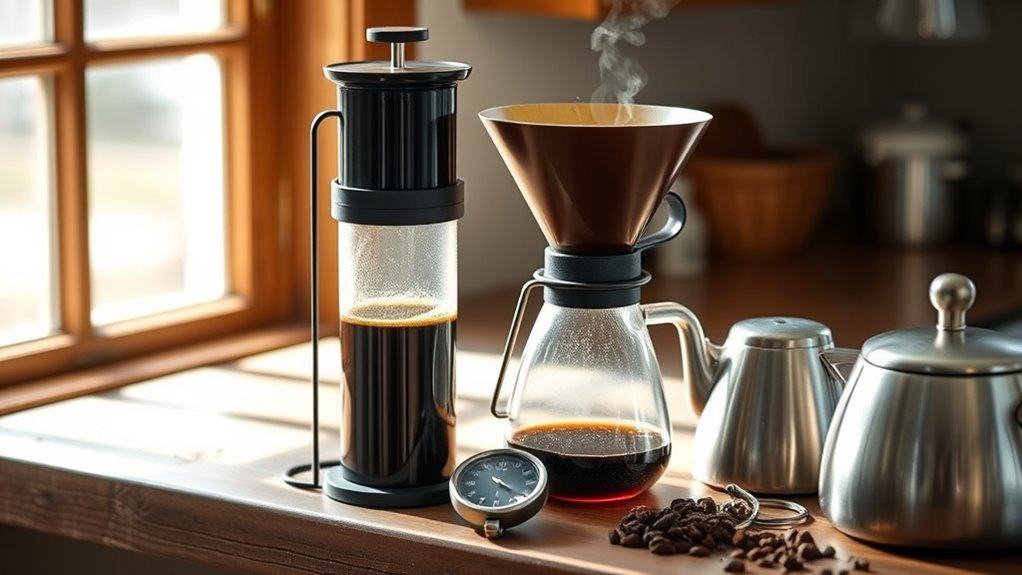
When choosing a coffee brewing method, you’ll want to weigh how long each process takes against how simple it is to clean afterward. Some techniques demand patience with extended steeping or extraction times, while others prioritize speed without sacrificing quality. Additionally, the cleanup effort can vary greatly, influencing how practical each method is for your daily routine.
Brewing Duration Comparison
Different coffee brewing methods vary considerably in the time they take, impacting how quickly you can enjoy your cup. When comparing Aeropress and Chemex, brewing efficiency and timing precision are vital. The Aeropress typically brews in about 1-2 minutes, offering rapid extraction with precise control over steeping time, which suits your need for speed without sacrificing flavor. Conversely, the Chemex demands a longer process—usually 4-5 minutes—due to its slower drip filtration, emphasizing clarity and balance in the cup. While the Chemex requires more patience, it allows a more measured control over pour rate and saturation. Ultimately, your choice hinges on whether you prioritize quick, efficient brewing or a deliberate, nuanced extraction experience. Both methods empower you with timing precision but cater to different rhythms.
Ease of Cleanup
While brewing duration influences how quickly you get to savor your coffee, the ease of cleanup plays a significant role in the overall convenience of your brewing routine. When comparing Aeropress and Chemex, cleanup efficiency and post brew maintenance vary significantly. With Aeropress, you simply eject the coffee puck and rinse the parts, making it quick and straightforward. Chemex requires discarding the used filter and grounds, followed by washing the carafe, which can be more time-consuming. Consider these factors:
- Aeropress parts are compact and dishwasher-safe, enhancing cleanup efficiency
- Chemex’s glass body demands gentle handling during post brew maintenance
- Paper filters in Chemex add disposal steps absent in Aeropress
- Aeropress’s design minimizes residual coffee oils, simplifying cleaning
- Chemex requires more drying time due to its shape and material
Ultimately, your preference for freedom in routine determines which cleanup suits you best.
Which Method Suits Different Coffee Drinkers?
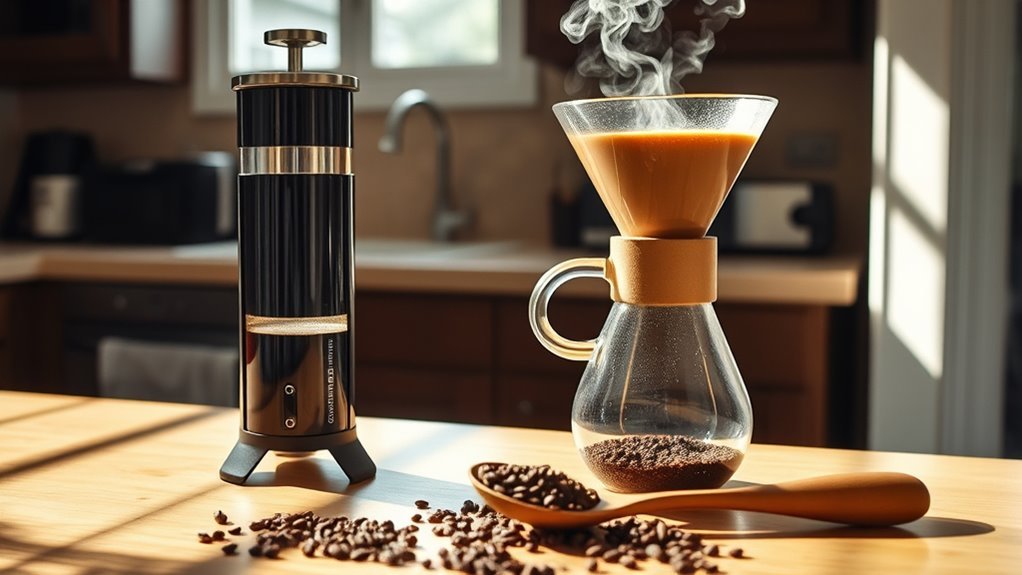
How do you determine which coffee brewing method best fits your taste and lifestyle? Start by evaluating your coffee preferences and brewing experiences. If you value a rich, clean cup with nuanced flavors, the Chemex might be your ideal choice, offering a slower, more deliberate process that highlights subtle notes. Conversely, if you prefer a bold, versatile brew and crave speed and portability, the Aeropress suits your dynamic routine. Your lifestyle also matters: Chemex demands patience and space, while Aeropress excels in convenience and ease of cleanup. Consider how much control you want over variables like grind size and brew time. Ultimately, selecting between these methods aligns with your desire for freedom—whether that means savoring a crafted ritual or embracing efficiency without sacrificing quality.
Frequently Asked Questions
Can Aeropress and Chemex Be Used for Cold Brew Coffee?
You can use both Aeropress and Chemex for cold brew, but the process differs. Cold brew requires a low brewing temperature, typically room temperature or colder, to extract smooth flavors over time. With an Aeropress, you might experiment with a longer steep at cooler temps. Chemex is more traditional for hot brewing, but you can adapt it by letting grounds steep in cold water before filtering. Both offer freedom to customize your cold brew experience.
How Do Grind Sizes Differ Between Aeropress and Chemex?
Though both methods demand precision, your grind size shifts dramatically between them. For Aeropress, you’ll use a medium-fine grind to balance extraction speed and brewing consistency, allowing you to experiment freely. The Chemex, however, calls for a coarser grind—similar to sea salt—to guarantee a slower, even drip that highlights clarity. By mastering these contrasts, you gain control over flavor nuances and reveal your ideal cup every time.
What Is the Environmental Impact of Aeropress vs. Chemex Filters?
When considering filter sustainability, you’ll find Aeropress uses metal or recyclable paper filters, promoting waste reduction by minimizing disposable materials. Chemex relies on thick paper filters, often compostable but single-use, which can generate more waste over time. If you’re aiming for eco-friendliness and freedom from constant replacements, Aeropress’s reusable options give you greater control over minimizing environmental impact without compromising your brewing experience.
Are There Any Health Benefits Linked to Each Brewing Method?
When it comes to health benefits, you’ll find each brewing method has its own flavor in the pot. Chemex uses thick paper filters, which trap oils and sediments, potentially reducing cholesterol-raising compounds in your cup. Aeropress, meanwhile, allows more oils through but brews quickly, preserving antioxidants. So, depending on your health goals, you can enjoy freedom in choice—whether you want a cleaner cup or a richer antioxidant boost in every sip.
Can Either Method Be Used Effectively at High Altitudes?
You can definitely use both methods effectively at high altitude, but brewing efficiency varies. High altitude means lower air pressure, which slows water boiling and extraction. With Aeropress, you have more control over time and pressure, helping you adapt quickly. Chemex relies on gravity and slower drip, so you might need longer brew times or finer grind. By adjusting these factors, you’ll maintain strong, balanced coffee even where oxygen’s thin.
